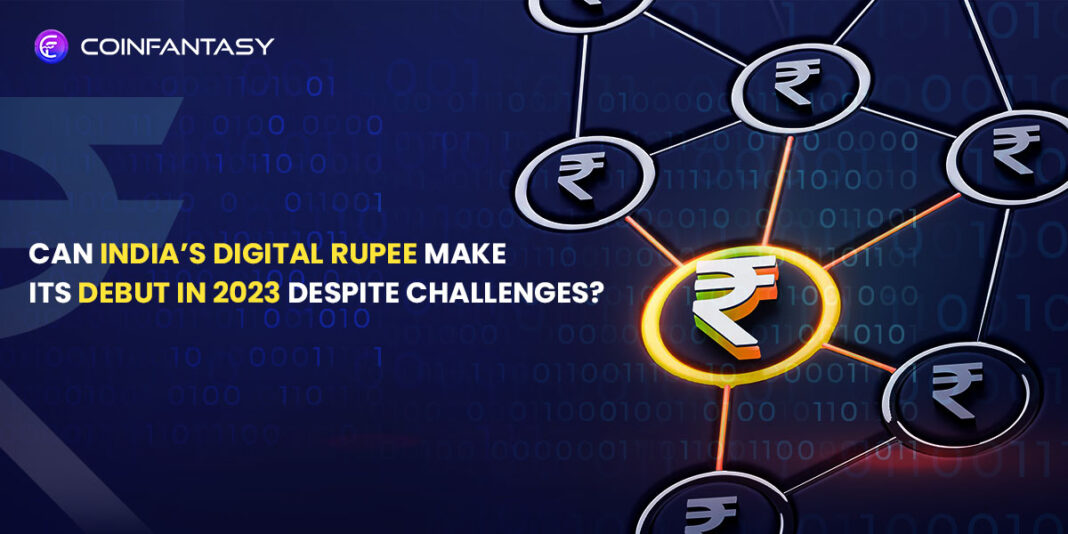The Indian government has been considering launching a digital version of the rupee for some time now. The idea of a digital rupee, also known as a Central Bank Digital Currency (CBDC), has gained traction in recent years as more and more countries explore the potential benefits of this new form of money.
According to the Finance Minister, “Digital currency will also result in a more effective and affordable currency management system. Therefore, it is suggested that Digital Rupee be introduced using blockchain and other technologies.
With the Indian government showing an increasing interest in digital currencies, many are asking whether the digital rupee could make its debut in 2023, despite the challenges that it may face.
One of the main challenges that the digital rupee will face is regulatory approval. While the Reserve Bank of India (RBI) has shown interest in digital currencies, the central bank has yet to release any official guidelines on the matter. This lack of clear regulations could make it difficult for the digital rupee to be adopted, as businesses and individuals may be hesitant to invest in an asset that still needs to be fully regulated.
Another challenge that the digital rupee will face is technological adoption. While India is one of the largest markets for digital technologies, it still needs issues of digital illiteracy and a lack of infrastructure to support a digital currency. To ensure that the digital rupee is successful, the government will need to invest in educating the public and developing the necessary infrastructure to support it.
Despite these challenges, there are also several reasons to believe that the digital rupee could be successful. For one, the digital rupee would help to increase financial inclusion in India, as it would allow more people to access banking services, including those who do not have access to traditional banking systems. Additionally, the digital rupee could also help to reduce corruption and increase transparency, as it would provide a more secure and transparent system for making transactions.
India’s Digital Rupee The trial phase!
“16,000 customers conducted e-rupee transactions in a single month during the CBDC pilot phase. The start is fantastic and has great promise for e-future, rupee’s “Amogh Tiwari, the founder of DayFi, an NFT-based provider of financial utilities, has this opinion.
According to an experts study, blockchain is expected to gain momentum in the upcoming years as the Ministry of Electronics and Information Technology releases a “National Strategy on Blockchain” in December 2021. It’s interesting to note that this paper brings up the concept of a government-backed digital currency wallet for farm industry transactions.
One of the most well-known applications of blockchain technology, which is regarded as secure, dependable, and transparent, is CBDCs. But any discussion of CBDCs would be incomplete without comparison to cryptos, which also operate according to blockchain principles.
Adopting digital assets like CBDCs and other assets underpinned by blockchain might help India’s economy grow by $1 trillion by 2032.
What else can it do?
Following are a few things that will happen:
#1. Transactions tracking
Similar to other digital wallets made available by private companies, RBI can monitor all blockchain transactions for the digital rupee. A user has the option to transfer money to a private company that will keep it on their behalf and pays a merchant once a transaction occurs. There are fees associated with transferring funds to a private company’s e-wallet, and the funds are also subject to the company’s credit risk.
#2. Regulations
On the comprehensive path for developing India’s own blockchain, the governing authority of the Central Bank Digital Currency (CBDC) has not yet been determined. Although digital currency is a virtual currency, it cannot be compared to other private virtual currencies that already exist. Because there is no issuer, existing private virtual currencies do not represent any person’s debt or liabilities.
#3. Cost cutting
CBDCs have the potential to drastically reduce the costs associated with producing, shipping, and storing physical currency for central banks. The brick-and-mortar banking paradigm will become less important in a world where digital currencies are widely utilized for everyday transactions. In addition to reducing financial fraud, CBDCs will tackle urgent problems, including money laundering and financing for terrorism.
Wrapping up
In conclusion, the launch of the digital rupee in India is an exciting development that has the potential to bring many benefits to the country. While it will face several challenges, including regulatory approval and technological adoption, the potential benefits make it an attractive option for the Indian government. Whether the digital rupee will make its debut in 2023 remains to be seen, but it is clear that the future of money in India will likely be digital.

